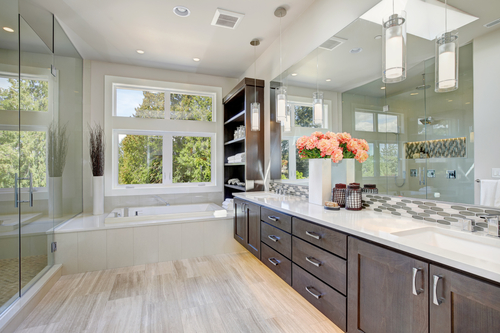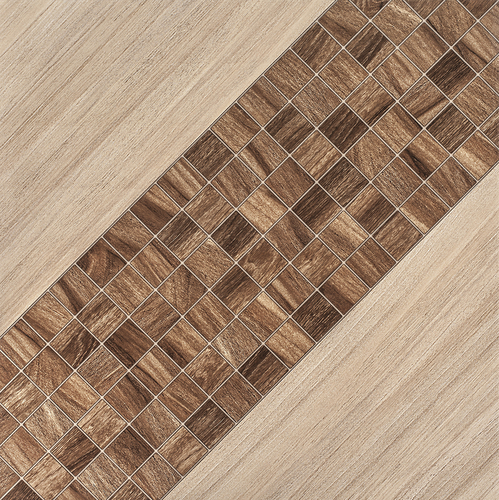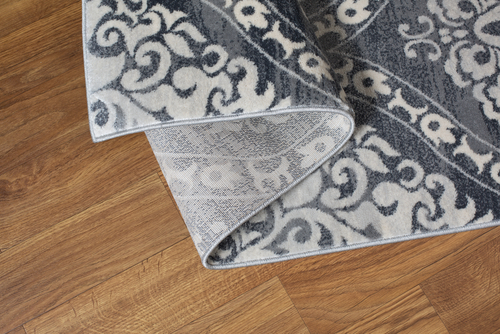Laying Laminate Flooring In Small Bathroom
Installing Laminate Flooring in Your Bathroom? 6 Things to Keep in Mind

-
Resembles real wood—Laminate flooring styles have come a long way and are now offered in realistic visuals and textures. It can also mimic the look of hardwood with texture that follows the grain in the print film, but with the added benefit of being water resistant and generally more affordable.
-
Easy installation—Laminate flooring is easy to install, resulting in a fast and simple DIY project that homeowners can accomplish over a weekend.
-
Offers protective layer—Laminate flooring provides a top layer that resists everyday wear and tear, making maintenance fairly easy. Simply sweep the floor or spot clean with a damp mop–no need to apply coats and finishes. Not to mention, it protects from the accidental drop of a flat iron.
However, while laminate flooring may be the best choice for certain rooms in your home, it does have some drawbacks in bathrooms. First, you must evaluate whether laminate floors are the right choice for the specific bathroom for which you plan to install. And second, homeowners need to be aware that laminate requires certain upkeep to make it last within a damp bathroom.
Choose a quality waterproof laminate for your bathroom and it can last a long time, so long as you keep a few things in mind.
6 Considerations for Installing Laminate Flooring in Your Bathroom
1. Install in Smaller Bathrooms
Laminate flooring is best suited for small bathrooms, such as a downstairs half bath or more intimate master suite bathroom.
Half baths, with only a sink and toilet, lack the tub or shower to create spillage or humidity. And smaller bathrooms connected to master bedroom suites are usually more diligently watched and maintained on a daily basis.
2. Use Waterproof Silicone Caulk (REQUIRED)
One of the easiest and most important steps you must take to protect your laminate flooring is to use a waterproof silicone caulk upon its initial installation. Unlike your standard grout made of cement and sand, which can absorb water, silicone is flexible and impenetrable.
Also, silicone caulk yields quite nicely to laminate as it naturally expands and contracts to fill flooring gaps. Without the use of silicone caulk, your warranty will most likely be void and your floor will fail in a bathroom setting. Prior to installation, consult with your retailer and contractor to address this detail.
3. Line the Edges with Tile

While the silicone grout is excellent at protecting the inner joints and adjacent laminate tiles and planks, it's not adequate protection for where the laminate flooring ends. Without some sort of barrier, water is bound to get in and can reach beneath the laminate, causing larger issues.
One solution is to incorporate a decorative, hard tile border, baseboard or molding around the laminate flooring, specifically the bathtub, shower, vanity sinks and toilet. This will help seal off the outer edges from moisture or splashes from, say, your deep bubble baths.
4. Minimize Humidity
Even more than kitchens, bathrooms will see high levels of humidity, especially since it has a shower that steams up the entire room. Because laminate flooring is susceptible to moisture and can warp, it's important to take precautions and reduce it as much as possible.
Remember to run the exhaust fan while taking a shower. And if you can, even open windows to allow the room to breathe.
5. Prevent Standing Water
While the general humidity of bathrooms is a given, standing water can be prevented. One of the best ways to prevent water damage is to wipe or mop up any standing water. Allow a puddle to linger and you could eventually have a problem on your hands. As water can seep between the seams of laminate flooring, it can then turn into mold, which is a bigger problem that could lead to repairs or the cost of an entire subfloor replacement.
6. Lay Down Rugs

Rugs and carpets add a warm, comfortable place to step out of the shower or add support as you primp and prep at the vanity mirror. But placing down bath rugs and runners can also protect and preserve your laminate flooring.
Laying down rugs not only prevents standing water, but it also can keep a sure-footing and prevent you from slipping, especially as you step out of the shower or bathtub. And when using laminate, this is a cause for concern as it does get quite slippery when wet, which can be dangerous. However, many laminate manufacturers have recognized this risk and since taken necessary steps to enhance the texture, creating more grip and traction.
Is Laminate Flooring Right for Your Bathroom?
Keeping all these things in mind, now is the time to decide if laminate flooring is right for you. If so, Twenty & Oak has some fantastic options. Hydrana water resistant laminate from Beauflor actually offers a 72-hour standing water warranty. Due to the extremely tight locking system, you can have the peace of mind that Hydrana can handle a splash that sits for a while. The beautiful, authentic design of this collection includes eight diverse colors to complement any bathroom style. The attached pad provides outstanding noise reduction and superior comfort underfoot.
It takes some effort to maintain laminate flooring. However, if you feel your bathroom can benefit from more worry-free flooring, there are many other options suitable for bathrooms. Both waterproof flooring and Luxury Vinyl Plank (LVP) flooring are excellent alternatives for bathrooms.
Twenty & Oak Experts
Twenty & Oak Experts are a team of flooring professionals with over 150 years of combined experience in the industry. They have hands-on experience with all flooring types and bring inside industry know-how to homeowners in the Southeast.
Laying Laminate Flooring In Small Bathroom
Source: https://twentyandoak.com/education/buying-guide/installing-laminate-flooring-in-your-bathroom

0 Komentar